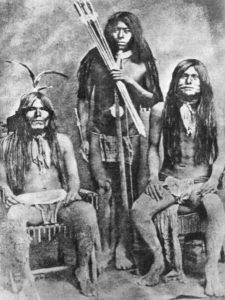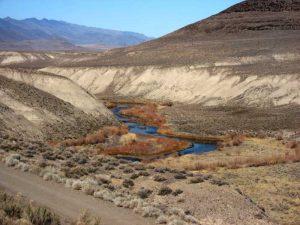
Paiute Indians
Paiute War (Summer, 1860) – Also known as the Pyramid Lake War, Washoe Indian War, and the Pah Ute War, this armed conflict resulted due to the Paiute Indians’ resentment of miners and settlers in the Carson River Valley of western Nevada. In the late 1850s, the fertile valley, a welcome sight to emigrants passing over the Carson Branch of the California Trail after traversing an inhospitable stretch of desert, had become the site of two trading posts, the Buckland and Williams Stations. They were Central Overland Mail and Pony Express stations and supplied miners and emigrants.
The war was preceded by increasingly violent incidents, culminating in two pitched battles in which approximately 80 Americans were killed. The number of Paiute killed in action is unrecorded. Most conflicts took place in the summer of 1860 near Pyramid Lake. Smaller raids and skirmishes continued until a cease-fire was agreed to in August 1860; however, a treaty was never negotiated.
Williams Station Massacre (1860) – The Williams Station Massacre was the incident that ignited the Pyramid Lake War of 1860. Accounts vary as to the exact details leading to the events at Williams Station, but most accounts say that two Paiute girls were abducted by traders, held at the station, and assaulted.
Unbeknownst to their chief, Paiute warriors returned to the station on May 7, 1860, forcing five white men believed to be have been responsible for the kidnapping inside the building. These men, including Oscar Williams, 33; David Williams, 22; Samuel Sullivan, 25; John Fleming, 25; and “Dutch Phil,” were forced into the building, and the station was burned, with all five men dying inside. Station operator and owner J.O. Williams was camping a couple of miles further up the river and thus escaped the fate of his brothers.
The men’s deaths led to a great panic in nearby Virginia City, Nevada. Within no time, a militia was formed from Virginia City, Silver City, Carson City, and Genoa volunteers to apprehend the perpetrators. This force consisted of about 105 men and was under the overall command of Major William Ormsby.
The site of Williams Station is now submerged beneath Lahontan Reservoir.

Pyramid Lake Battle Site in Nevada, courtesy Wikipedia
First Battle of Pyramid Lake (1860) – Twice in 1860, Paiute Indians, resenting the intrusion of miners and settlers in the Carson River Valley of western Nevada, clashed with troops at this battlefield north of the valley. In the late 1850s, the fertile valley, a welcome sight to emigrants passing over the Carson Branch of the California Trail after traversing an inhospitable stretch of desert, had become the site of two trading posts, the Buckland and Williams Stations. They were Central Overland Mail and Pony Express stations and supplied miners and emigrants.
Paiute, aroused by the abduction of two Indian girls by traders at the Williams Station, burned it and killed five men in what has become known as the Williams Station Massacre. In retaliation, a volunteer militia was formed from miners at Virginia City, Carson City, Genoa, and Gold Hill under the leadership of Major William M. Ormsby. The volunteer force of 105 men was organized at Buckland Station, near Fort Churchill, and began the trek to the ruins of William Station. Accounts of the expedition indicate that the men were poorly armed, badly mounted, and almost completely unorganized. Finding no one at the station, they proceeded north to the Truckee River and toward Pyramid Lake.
On May 12, 1860, they encountered a small party of Paiute who they attacked. The Paiute quickly fled with the militia in pursuit. It was an ambush. The warriors fled into a ravine, where some 200-300 Paiute warriors awaited them. Trapped in the ravine with no escape, 76 of the 105 militiamen were killed, including Major Ormsby, and many others were wounded. The survivors fled while being pursued some 20 miles. The number of Paiute killed is not recorded, but the number is thought to be quite small in comparison.
News of the defeat threw miners and settlers into a frenzy of fear and temporarily halted stage and Pony Express service over the western end of the Central Overland Mail route.
Second Battle of Pyramid Lake (1860) – After Ormsby’s defeat in the First Battle of Pyramid Lake, settlers called upon legendary Texas Ranger Colonel John C. Hays to lead another expedition against the Paiute. Reinforcements rushed in from California, and by the end of the month, some 800 men, including some Regulars, were under arms in Carson Valley. Dubbed the “Washoe Regiment,” it was composed of 13 companies of volunteers from the areas surrounding Carson City and Virginia City, Nevada, as well as Sacramento, California. The U.S. Army regulars were sent from Fort Alcatraz, California, under the command of Captain Joseph Stewart.
Without waiting for Captain Stewart’s troops, Colonel Hays led his men towards the site of Williams Station, where he and his volunteers encountered the Paiute on June 3, 1860. In a three-hour battle, six of the Indians died, and the survivors fled into the hills. Two of the volunteers were also killed.
Captain Stewart soon joined Hays’ forces, and the troops retraced the steps of Ormsby’s command and met the Numaga’s Paiute warriors at the same location as the First Battle of Pyramid Lake.
In the Second Battle of Pyramid Lake, Hays and Stewart defeated the Paiute, killing some 160 Paiute warriors and suffering four casualties. The Paiute forced then scattered across the Great Basin. After a minor skirmish in the Lake Range northeast of Pyramid Lake, the volunteer forces were disbanded. However, Captain Stewart and his regulars stayed in the area to construct Fort Churchill near Buckland Station, tasked with keeping watch over the defeated Paiute and guarding the stage and mail routes. Small skirmishes and raids continued until August when an informal cease-fire between Numaga and white surveyors working north of Pyramid Lake was achieved.
The battle site, located on the Pyramid Lake Indian Reservation, is virtually unchanged from its historic appearance. It lies in the lowlands along the east bank of the Truckee River, just off Nevada Highway 34, about four miles southeast of the southern tip of Pyramid Lake and immediately south of Nixon. A marker across the street from the Nixon Post Office commemorates the battlefield.
Compiled by Kathy Alexander/Legends of America, updated March 2023.
Also See:
Indian Wars, Battles & Massacres
